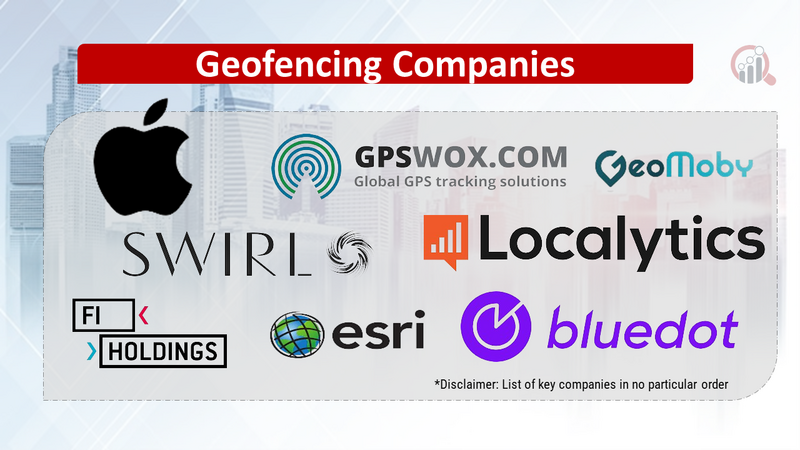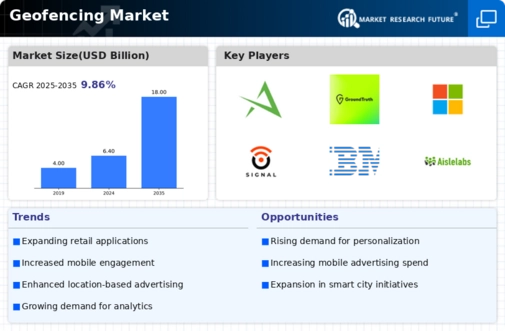Top Industry Leaders in the Geofencing Market

Geofencing Market: Dive into the Latest News and Updates
In today's hyper-connected world, location data unlocks a treasure trove of insights and opportunities. This is where geofencing steps in, acting as a virtual fence, triggering pre-defined actions when devices enter or exit designated geographic areas. This report delves into the dynamic Geofencing Market
Some of Geofencing Companies Listed Below:
- Apple INC. (U.S.)
- Thumbvista (U.S.)
- Pulsate (U.S.)
- Fi Holdings Inc. (U.S.)
- Esri (U.S.)
- Bluedot Innovation (U.S.)
- Geomoby (Australia)
- GPSWOX Ltd. (U.S.)
- Localytics (U.S.)
- Swirl Networks Inc. (U.S.)
Strategies Fueling Growth:
- Integration and Openness: Providing APIs and seamless integration with existing platforms, marketing tools, and CRM systems simplifies geofencing implementation and data utilization.
- Advanced Analytics and Insights: Offering tools for analyzing user movements, dwell time, and visit frequency within geofences empowers businesses to gain deeper customer understanding and optimize operations.
- Personalization and Targeted Engagement: Using geofencing triggers to deliver personalized content, discounts, or notifications based on user location enhances customer experience and drives engagement.
- Security and Compliance: Robust security features, data encryption, and compliance with privacy regulations build trust and open doors to data-sensitive applications.
Market Share Decoding: Key Factors to Consider:
- Functionality and Feature Set: Platforms offering diverse geofencing capabilities, including customizable geofences, real-time alerts, and advanced analytics tools cater to varied business needs and complexities.
- Scalability and Performance: Ability to handle large volumes of location data, process geofencing triggers efficiently, and scale with business growth is crucial for enterprise-grade deployments.
- Pricing and Cost-Effectiveness: Flexible pricing models, pay-as-you-go plans, and tiered options based on usage make geofencing solutions accessible to businesses of all sizes and budgets.
- Ease of Use and Integration: User-friendly interfaces, APIs, and pre-built templates simplify geofencing implementation and accelerate time-to-value.
New and Emerging Stars: Illuminating the Geofencing Path
- Indoor Geofencing and Beacon Technology: Startups like Estimote and Aruba Networks develop solutions for indoor geofencing and proximity marketing, enabling location-based experiences within buildings, shopping malls, and other indoor environments.
- Real-Time Logistics and Asset Tracking: Companies like Samsara and Geotab integrate geofencing with fleet management and asset tracking solutions, optimizing logistics operations and enhancing supply chain visibility.
- AI-Powered Geofencing and Predictive Analytics: Startups like MapD and Boundless Spatial explore AI-powered geofencing solutions that predict user movements, personalize experiences, and automate location-based triggers based on user behavior.
Investment Trends: Where the Geofencing Dollars Flow:
- Location Intelligence Platforms: Investors are backing companies developing comprehensive location intelligence platforms that integrate geofencing capabilities with advanced analytics and data visualization tools.
- Indoor Geofencing and Beacon Technology: The growing adoption of smart buildings and beacons creates investment opportunities for companies developing indoor geofencing solutions and location-based services within enclosed spaces.
Latest Company Updates:
October 26, 2023:
- Google Maps Platform introduces "Geofences API" for developers: This new API simplifies location-based app development, enabling developers to easily create triggers and actions based on users' movement within defined geographic areas.
- Retail giant Walmart leverages geofencing for personalized in-store promotions: Customers receive targeted offers and coupons based on their proximity to specific store locations, boosting engagement and sales.
November 15, 2023:
- Focus on privacy and ethical considerations: Concerns about data collection and user tracking are prompting stricter regulations and responsible geofencing practices.
December 7, 2023:
- Apple tightens geofencing restrictions for location-based advertising: This move aims to improve user privacy and control over how their location data is used.
- Geofencing technology adopted for wildlife conservation: Researchers use geofences to track animal movements and protect endangered species from human encroachment.
January 9, 2024:
- Integration with artificial intelligence (AI) and machine learning (ML): AI and ML are being used to analyze geofencing data and generate insights for smarter marketing campaigns, improved logistics, and predictive maintenance.
- Rise of hyperlocal geofencing: This technology defines smaller, more precise geofences for hyper-targeted offers and personalized experiences based on users' real-time location.









